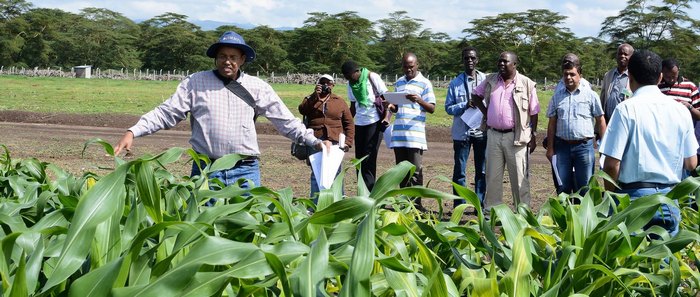“We are all gravely concerned about the rapid spread of maize lethal necrosis [MLN], not just due to the wide prevalence of insect vectors that can transmit the MLN-causing viruses, but also due to production, distribution and cultivation of commercial seed contaminated with MLN pathogens,” said Stephen Mugo, CIMMYT’s Regional Representative for Africa, at the opening of the recently concluded three-day International Conference on MLN Diagnostics and Management in Africa. This captures a core message the conference – seed transmission is a primary means of MLN’s spread in East Africa.
Jointly organized by the Alliance for a Green Revolution in Africa (AGRA), CIMMYT and the Bill & Melinda Gates Foundation in collaboration with the Kenya Agricultural and Livestock Research Organization (KALRO), the conference brought together scientists, regulators and policymakers from 17 African countries, USA and Mexico, to discuss how to effectively control seed transmission of MLN pathogens, especially to non-endemic countries.
MLN presents a new and unprecedented challenge to East Africa’s robust seed industry since it can be transmitted through infected seed. Needless to say, seed companies are crucial in limiting seed contamination and thus in stemming further spread of the disease. For this reason, major seed companies participated in the conference to help map feasible joint action to control transmission through seed. Companies in MLN-endemic areas of East Africa are already feeling the heat from the disease leading to massive production losses, increased production costs and reduced sales. “We have had to shut down almost all our maize-production sites in the endemic areas across eastern Africa because of major losses attributed to MLN,” said Kassim Owino from Seed Co, Kenya.
Officials at the opening of the MLN international conference in Nairobi. Left to right: George Bigirwa (standing, AGRA), Stephen Mugo (CIMMYT), Joe DeVries (AGRA), Felister Makini (KALRO) and Gary Atlin (Bill & Melinda Gates Foundation).
Seed poses a problem, but also presents a solution
“The seed sector can ensure that when a series of MLN-resistant varieties are developed, farmers benefit from the seed. But we must recognize the fact that in the case of MLN, the seed sector can also be a factor in its spread. So we need to work together to identify means of preventing spread,” remarked Dr. Joe DeVries, Director of AGRA’s Program for Africa’s Seed Systems.
Collective efforts will be required not only to control the spread of MLN but also to effectively manage the disease where already present, including developing and deploying new MLN-resistant varieties as a lasting solution. Ongoing research to develop MLN-resistant varieties is at the core of CIMMYT’s work in Africa and is being undertaken in close partnership with the private and public sectors including seed companies. The Africa RISING Project and the CGIAR Research Program on MAIZE have also supported these efforts. However, there are no quick solutions, and developing and disseminating MLN-resistant maize varieties will take several years.
In the meantime, seed companies and seed producers need to ensure that seed is MLN-free. To do this, they require support to train their personnel to recognize early infection in addition to adopting best practice on surveillance, diagnostics and management of MLN. CIMMYT’s MLN diagnosis and protocols and MLN-free seed production are examples of best practice. In parallel, regional phytosanitary bodies need to regulate and monitor production and movement of seed, especially into areas currently unaffected.
What next and what needs to be done?
The CIMMYT–KALRO MLN screening facility at Naivasha, Kenya, will continue to have a critical role in the ongoing research. This facility screens germplasm from transnational and national seed companies, and from national research programs. Conference participants visited the facility and witnessed MLN leaf sampling and ELISA diagnostics systems, as well as experimental maize hybrids demonstrating promising MLN tolerance. Seed companies were invited to send their germplasm for screening for the current cropping season.

Viewing experimental maize hybrids at the MLN screening facility with explanations from CIMMYT staff.
Other than a recent CIMMYT study on Kenya, there is little information on MLN incidence, distribution, severity and impact. More studies like this would help to quantify the magnitude of the disease.
The conference made important recommendations on joint action and regional protocols, summed up by Gary Atlin from the Bill & Melinda Gates Foundation:, “Efforts to manage seed production within an environment that seems conducive to the spread of MLN are very important. There are strategies and tools available that can help manage the disease. We hope to get a clear picture of these strategies and how they can be applied in the region’s seed systems, to safeguard the maize-seed supply for African farmers and ensure delivery of germplasm continues in the positive direction it has been moving.”
Some of the presentations from the conference are on SlideShare.
The conference was widely reported in national and regional newspapers and television, as indicated by the links below.
Links
- Conference press release
- BBC Science in Action, 3rd chapter, ‘Disease hurts African Maize’ (audio clip accessible until January 15, 2016)
- Videos on MLN – A farmer’s plea | MLN in East Africa | Audio slideshow from SciDev.Net | MLN in Tanzania
- March 2015 regional training workshop and slides
- Factsheets – MLN in Kenya and Tanzania | MLN Screening Facility
 Capacity development
Capacity development 
